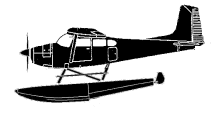
ASN Wikibase Occurrence # 137780
This information is added by users of ASN. Neither ASN nor the Flight Safety Foundation are responsible for the completeness or correctness of this information.
If you feel this information is incomplete or incorrect, you can submit corrected information.
| Date: | Saturday 30 July 2011 |
| Time: | 14:15 |
| Type: |  Cessna 180B Skywagon (float plane) |
| Owner/operator: | Private |
| Registration: | N5214E |
| MSN: | 50514 |
| Year of manufacture: | 1959 |
| Fatalities: | Fatalities: 4 / Occupants: 4 |
| Aircraft damage: | Destroyed |
| Category: | Accident |
| Location: | Near Amber Lake, Trapper Creek area, AK -
 United States of America United States of America
|
| Phase: | En route |
| Nature: | Private |
| Departure airport: | Anchorage, AK (PALH) |
| Talkeetna, AK | |
| Investigating agency: | NTSB |
| Confidence Rating: |
Two float-equipped, high-wing airplanes, a Cessna U206G (N756MP) and a Cessna 180 (N5214E), collided in midair in day visual meteorological conditions near a remote lake, which was the destination for both airplanes. The Cessna 206 pilot stated that he was maneuvering for landing after completing a right 270-degree turn, which positioned the airplane for a left downwind approach for landing to the northeast. The Cessna 180 was flying northbound and presumably also on a left downwind approach for landing to the northeast. The airplanes were about 900 feet above ground level when the collision occurred. The pilot of the Cessna 206 said he saw the Cessna 180 approaching from the right, and he made an immediate climbing left turn just before the collision. The Cessna 180 descended vertically to the ground. The Cessna 206 continued to fly and landed safely with the outboard portion of the Cessna 180’s left wing entangled in its floats. Neither pilot was in communication with any air traffic control facility. The airplanes were operating in uncontrolled airspace.
The Cessna 206 pilot reported that he was monitoring 122.8 MHz, the common traffic advisory frequency (CTAF) for the area. A pilot-rated relative of the Cessna 180 pilot said the pilot monitored 122.9 MHz on previous flights, which was the MULTICOM frequency used for off-airport operations.
A review of FAA-approved CTAF radio frequencies used in the area revealed equivocal language regarding which CTAF radio frequency should be used. Additionally, due to a high concentration of aerodromes in the area, many of the frequency boundaries overlap.
Given the reports of the radio frequencies that were monitored by both pilots, it is likely that, had both pilots been announcing their intentions on the same frequency, both pilots would have had increased awareness of the presence of the other airplane.
Probable Cause: The inadequate visual lookout and failure to see and avoid by the pilots of both airplanes while maneuvering to land, which resulted in a midair collision. Contributing to the accident was the lack of standardized, unequivocal procedures concerning common traffic advisory frequencies used in the area.
Sources:
NTSB
Location
Revision history:
| Date/time | Contributor | Updates |
|---|---|---|
| 31-Jul-2011 03:15 | RobertMB | Added |
| 31-Jul-2011 03:17 | RobertMB | Updated |
| 31-Jul-2011 20:21 | RobertMB | Updated [Aircraft type, Registration, Cn, Operator, Source] |
| 21-Dec-2016 19:26 | ASN Update Bot | Updated [Time, Damage, Category, Investigating agency] |
| 27-Nov-2017 17:01 | ASN Update Bot | Updated [Operator, Total occupants, Other fatalities, Nature, Departure airport, Destination airport, Source, Narrative] |
Corrections or additions? ... Edit this accident description
The Aviation Safety Network is an exclusive service provided by:


 ©2024 Flight Safety Foundation
©2024 Flight Safety Foundation